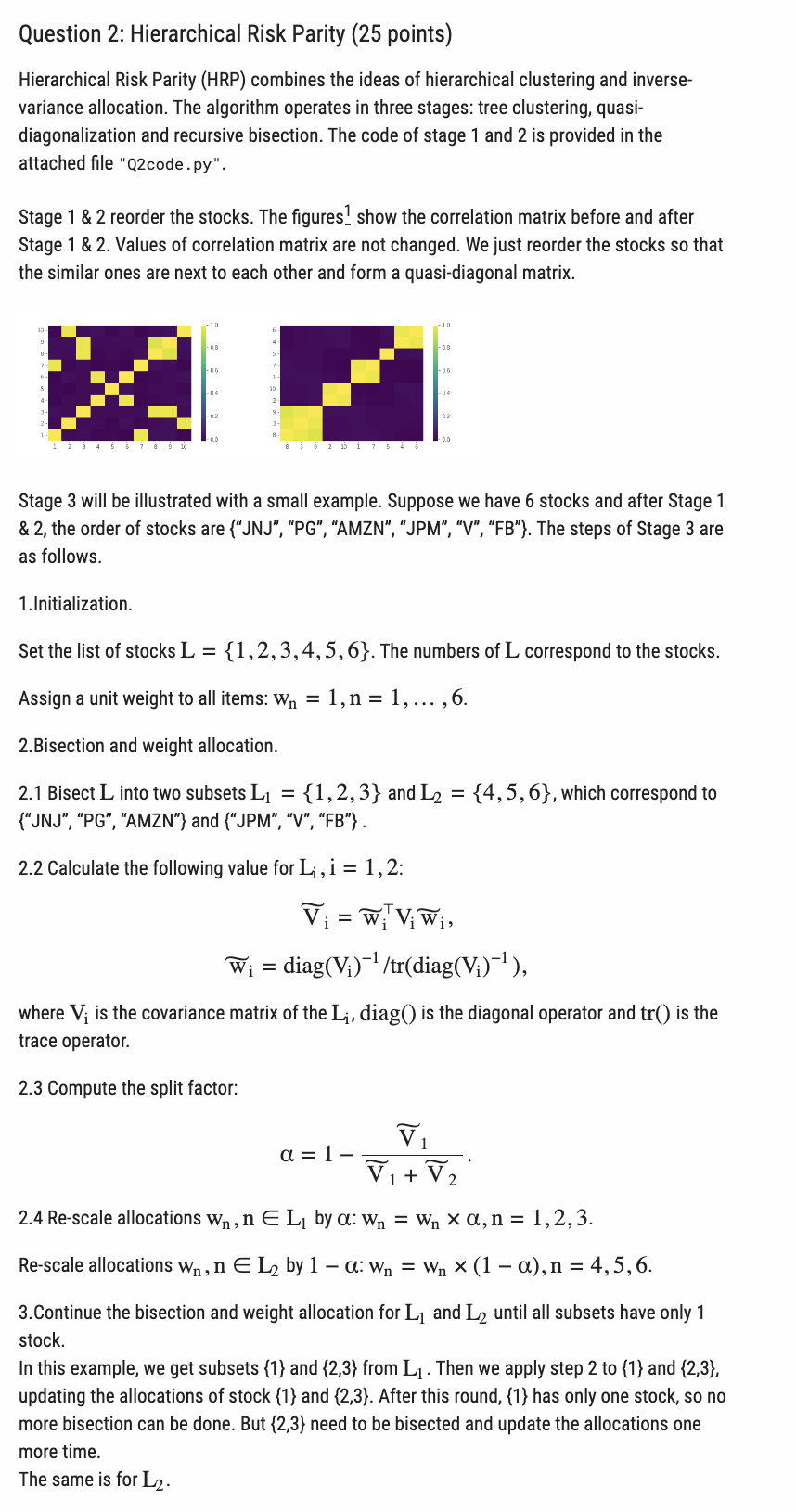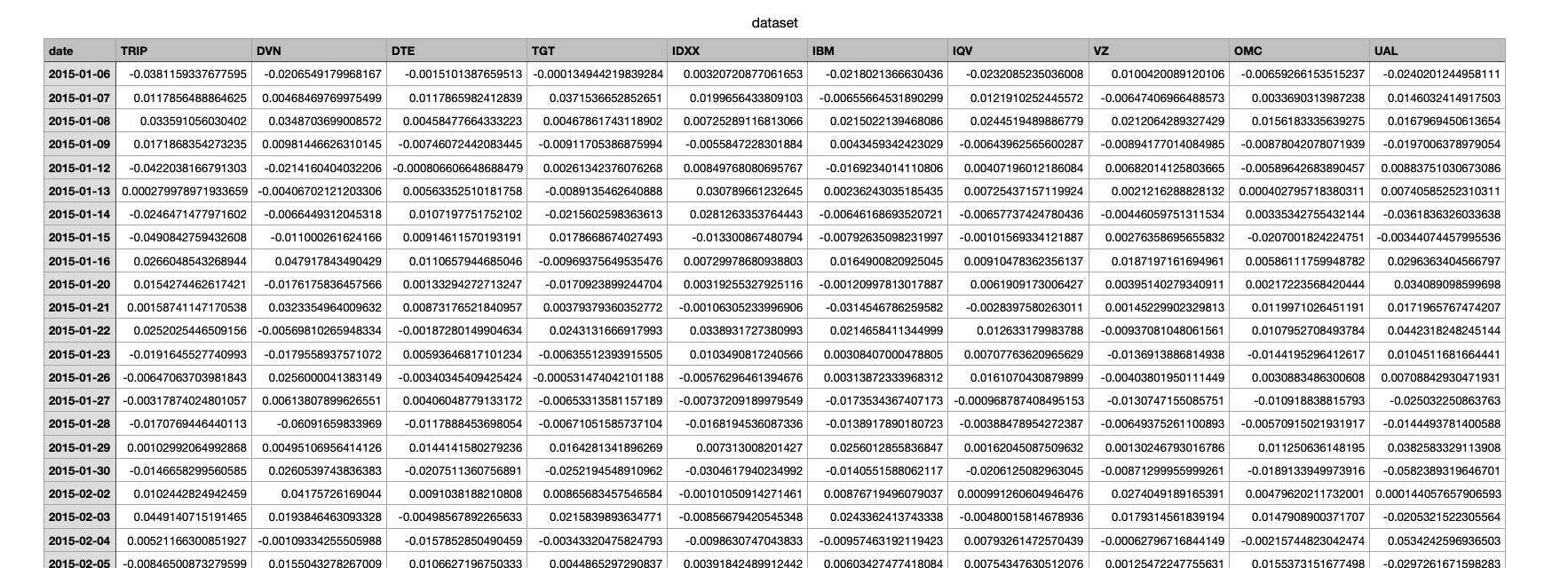Question
Codebase: import numpy as np import math import cvxpy as cp import pandas as pd import seaborn as sns import matplotlib.pyplot as plt import scipy.cluster.hierarchy

Codebase:
import numpy as np
import math
import cvxpy as cp
import pandas as pd
import seaborn as sns
import matplotlib.pyplot as plt
import scipy.cluster.hierarchy as sch,random
import warnings
warnings.filterwarnings('ignore')
plt.style.use('ggplot')
dataset_log_returns = pd.read_csv('dataset.csv', index_col=0, parse_dates=True)
# The function you need to write.
# Input: cov: a dataframe containing the covariance matrix of stocks.
# sortIx: a list containing the stocks names, ordered by the stage 1&2.
# You can add any input argument if you need.
# Output: allocation weight. You can output any data type as long as you can use it properly in Q3.
def getRecBipart(cov,sortIx):
# A sub function for the satge 1 and 2, called in the hrp_s12()
def getQuasiDiag(link):
link=link.astype(int)
sortIx=pd.Series([link[-1,0],link[-1,1]])
numItems=link[-1,3]
while sortIx.max()>=numItems:
sortIx.index=range(0,sortIx.shape[0]*2,2)
df0=sortIx[sortIx>=numItems]
i=df0.index;j=df0.values-numItems
sortIx[i]=link[j,0]
df0=pd.Series(link[j,1],index=i+1)
sortIx=sortIx.append(df0)
sortIx=sortIx.sort_index()
sortIx.index=range(sortIx.shape[0])
return sortIx.tolist()
# Transform the correlation matrix to a distance matrix
def correlDist(corr, n_stock):
dist=((1-corr)/2.)**.5
for i in range(n_stock):
dist.iloc[i,i] = 0
return dist
# Plot the heatmap of the correlation matrix
def plotCorrMatrix(path,corr,labels=None):
#
if labels is None:labels=[]
plt.pcolor(corr)
plt.colorbar()
plt.yticks(np.arange(.5,corr.shape[0]+.5),labels)
plt.xticks(np.arange(.5,corr.shape[0]+.5),labels)
plt.savefig(path)
plt.clf();plt.close()
return
# Function for Stage 1 and 2
def hrp_s12(cov,stock_namelist, ifplot = False):
n_stock = len(stock_namelist)
#1) compute and plot correlation matrix
v = np.diag(np.sqrt(1p.diag(cov)))
corr = np.dot(np.dot(v,cov), v)
cov = pd.DataFrame(cov, columns = stock_namelist, index = stock_namelist)
corr = pd.DataFrame(corr, columns = stock_namelist, index = stock_namelist)
if (ifplot): plotCorrMatrix('HRP_corr0.png',corr,labels=corr.columns)
#2) cluster
dist=correlDist(corr,n_stock)
link=sch.linkage(dist,'single')
sortIx=getQuasiDiag(link)
sortIx=corr.index[sortIx].tolist() # recover labels
df0=corr.loc[sortIx,sortIx] # reorder
if (ifplot): plotCorrMatrix('HRP_corr1.png',df0,labels=df0.columns)
return sortIx
def hrp_s3(cov,stock_namelist,sortIx):
cov = pd.DataFrame(cov, columns = stock_namelist, index = stock_namelist)
# Finish this function getRecBipart(cov,sortIx).
hrp = getRecBipart(cov,sortIx)
# Please print and check the "hrp" returned by the "getRecBipart(cov,sortIx)".
# The order of stocks in "hrp" maybe follow the "sortIx", which is different from the "stock_namelist".
# I suggest you to restore the order of "hrp" to "stock_namelist" here,
# in order to avoid mistakes in Q3.
# My "hrp" is a pandas.series, so this is what I do:
hrp = hrp[stock_namelist]
# It's OK if you want to finish this step in "getRecBipart()".
# It's also Ok if you want to skip this step here and deal with this small order problem in Q3.
return hrp
if __name__ == '__main__':
stock_namelist = dataset_log_returns.columns.values.tolist()
log_returns_1 = dataset_log_returns.loc['2015-01-06':'2015-05-29']
Sigma = np.cov(log_returns_1.T)
# Fill in the right argument to get the plots and new order of stocks:
sortIx = hrp_s12(Sigma, stock_namelist, ifplot= )
# After finish the function of stage 3, call it and print the final weight:
w_hrp = hrp_s3(Sigma, stock_namelist, sortIx)
print(w_hrp)
dataset.csv

Step by Step Solution
There are 3 Steps involved in it
Step: 1

Get Instant Access to Expert-Tailored Solutions
See step-by-step solutions with expert insights and AI powered tools for academic success
Step: 2

Step: 3

Ace Your Homework with AI
Get the answers you need in no time with our AI-driven, step-by-step assistance
Get Started


